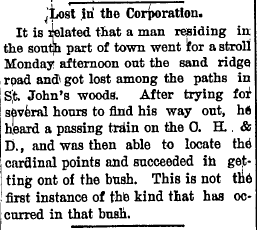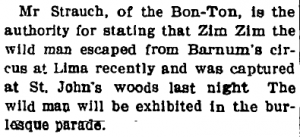Explore the press coverage of this story in the following articles.
An article published on Thursday, February 13th, 1896 in the Wood County Sentinel entitled “Lost in the Corporation” describes a man as “going for a stroll” on Sand Ridge Road and getting lost in St. John’s Woods. The short article ends stating, “This was not the first instance of the kind that has occurred in that bush.” This leads us to believe that multiple people have been lost in the woods, though there is no other evidence of these occurrences. This is significant in multiple ways. The first is that we know St. John’s is a recognizable landmark in Bowling Green. The second is that, unfortunately, we can infer that this happened to more than one person! There is also a reference to paths in the “deep bush” which allows us to understand that there were paths in the woods and what the terrain was like!
The previous incident does not seem to be isolated. The woods may have been a place that confused people, but some may have thought of it as a refuge. An article published on July 1st,1904 in the Daily Sentinel describes the escape and capture of the “wild man” from Barnum’s Circus in Lima, Ohio. After escaping the circus, the “wild man,” Zim Zim, was captured in St. John’s Woods on Monday, June 27th, 1904.
confused people, but some may have thought of it as a refuge. An article published on July 1st,1904 in the Daily Sentinel describes the escape and capture of the “wild man” from Barnum’s Circus in Lima, Ohio. After escaping the circus, the “wild man,” Zim Zim, was captured in St. John’s Woods on Monday, June 27th, 1904.
Learn More
Roderick Nash’s Wilderness and the American Mind argues that our term wilderness primarily applied to wooded areas without roads and human improvements. For long, that our ideas about wilderness were mostly negative and associated with disorder, madness, and lack of industry. Romanticism, the American landscape tradition, and then authors such as Henry David Thoreau and John Muir did much to change that perception of wilderness as chaos, to wilderness as a place to find ourselves as humans.
Photo credits
- Articles from the Sentinel and the Daily Sentinel-Tribune, listed above: Daily Sentinel July 1, 1904 and Wood County Sentinel Feb. 13, 1896
- Photograph by Charles Baither.
Text, research and content created by Julian Gillilan, Dual M.A. student in German and History. Edited by Dr. Amílcar Challú, Associate Professor of History, Bowling Green State University, and Carolyn Dailey, history senior.

